当我们在地球上感受岁月静好的时候,地球其实一直在载着我们在围绕着太阳公转,其速度大约为每秒30公里,太阳也不是固定不动的,它也一直在“带领”着太阳系中的众多天体在银河系中高速运动,其速度约为每秒230公里,而银河系中的恒星数量约为2000亿至4000亿颗,太阳只不过是其中之一。
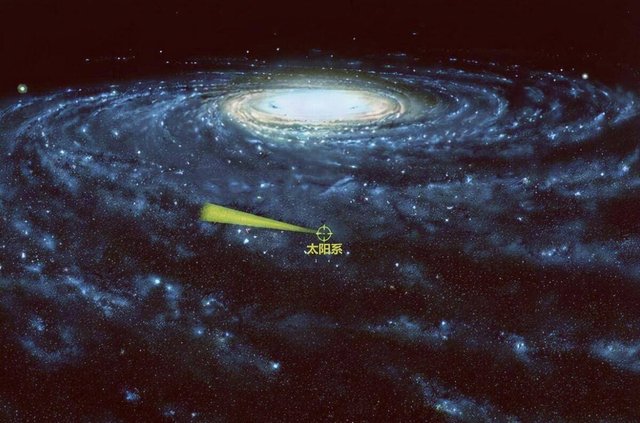
那么问题就来了,银河系有几千亿颗恒星,太阳在其中飞驰,为何没有“撞车”呢?总的来讲,这主要有两个原因。
第一个原因是,银河系所占的空间实在是太大了,以至于即使几千亿颗恒星分布在其中,也显得极为稀疏,有多稀疏呢?根据科学家的估算,银河系中的恒星平均密度大约为每立方光年0.006颗,换句话来讲就是,在银河系之中,恒星之间的平均距离大约有5.5光年。这是什么概念呢?
这样说吧,1光年大约是9.46万亿公里,太阳的直径约为139.2万公里,而足球的标准直径是22.1厘米,现在我们假设有两颗与太阳体积一样大、速度一样快的恒星,它们之间的距离为5.5光年,在这种情况下,如果我们将这两颗恒星缩小到足球那么大,那么在同等比例缩小之后,它们之间的距离就大约为8260公里,而它们的运动速度,则会缩小至大约每秒0.0365毫米。
想象一下,两个相距8260公里的足球,分别以每秒0.0365毫米的速度随机运动,它们“撞车”的概率有多低?
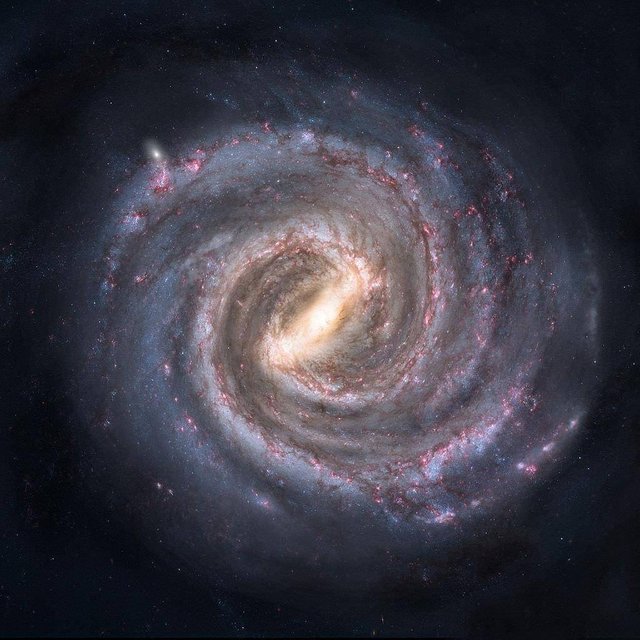
但这还没完,因为第二个原因会让这个概率进一步降低,这个原因就是:在银河系内,恒星的运动表现为一种有序而规律的状态,绝大多数恒星的运动并不是随机的,而是遵循着一种相对稳定的轨道围绕着银河系中心运行,进而使得银河系作为一个整体呈现出旋转的特性。
正是因为以上两种原因,太阳才没有与别的恒星“撞车”。当然了,银河系中的几千亿颗恒星也不可能做到完全同步地运行,它们之间或多或少都会有一些相对速度,而太阳形成于大约46亿年前,所以我们不难想象,在如此漫长的时间里,应该有一些恒星从太阳附近的空间掠过。
实际上,在天空中位于麒麟座方向、距离我们大约22光年的“WISE 0720-0846”,就可能是这样一颗恒星。
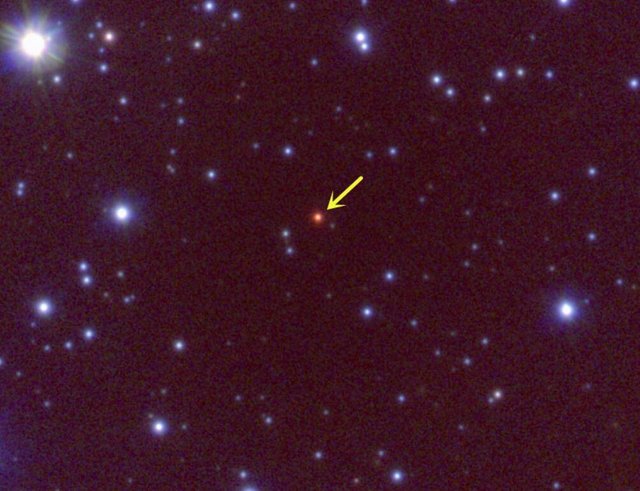
“WISE 0720-0846”又称“舒尔茨之星”(Scholz's Star),其质量约为太阳9.5%,它是一颗红矮星,科学家发现,这颗恒星目前正在远离我们而去,并且它相对于我们的切向速度非常低,以至于几乎可以忽略不计,而与之对应的是,在太阳系外围区域,大约有400个小天体都具有“夸张的双曲线轨道”,这说明了过去的日子里,它们曾经短暂地受到过某种强大引力源的干扰。
所以一个合理的推测就是,在遥远的过去,“WISE 0720-0846”很可能曾经从距离太阳很近的位置上“路过”,于是科学家利用已知的观测数据(如它位置、运动方向和速度以及银河系的引力场等)对其进行了建模,进而估算出,在大约7万年前,这颗恒星曾经从距离太阳大约0.82光年的位置上掠过。
需要知道的是,太阳系的半径就有大约1光年(以奥尔特云为界),也就是说,按这样的估算值来算,“WISE 0720-0846”其实已经是闯入了太阳系之内了。
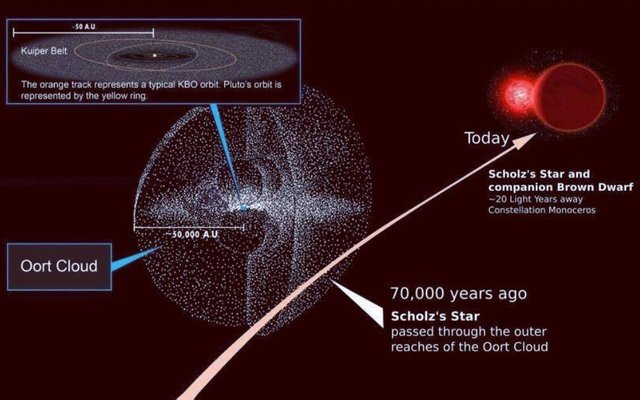
那么,既然过去很可能有恒星闯入过太阳系,那在未来会不会还有别的恒星再次闯入呢?答案是:有可能。
根据盖亚卫星发回的观测数据,科学家发现,有一颗名为“格利泽710”(Gliese 710)的恒星正在不断向太阳接近,这颗恒星在天空中位于巨蛇座,距离我们大约62光年。
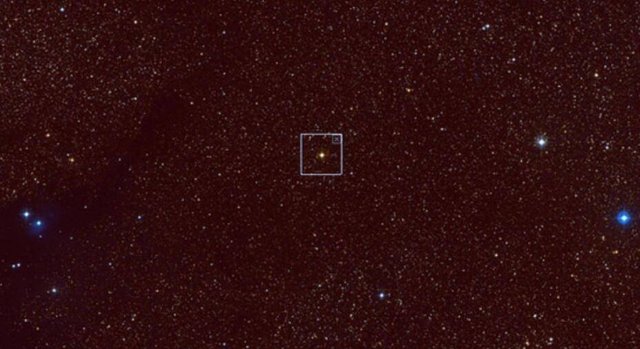
根据科学家的估算,在大约130万年之后,“格利泽710”就会闯入太阳系,而届时它与太阳的最近距离,可以低至0.1663光年左右。
可以看到,这样的距离可比“WISE 0720-0846”近多了,在此基础上,再加上“格利泽710”还是一颗质量比“WISE 0720-0846”大得多的橙矮星,其质量约为太阳的57%,所以科学家普遍对此表示担心。
可以想象的是,一颗质量如此巨大的恒星闯入了太阳系之后,太阳系中的众多小天体的运行轨道都会受到明显的干扰,进而导致地球遭到小天体撞击的风险大幅提升,甚至地球的运行轨道,都有可能受到影响,这对于人类来讲,显然不是什么好消息。
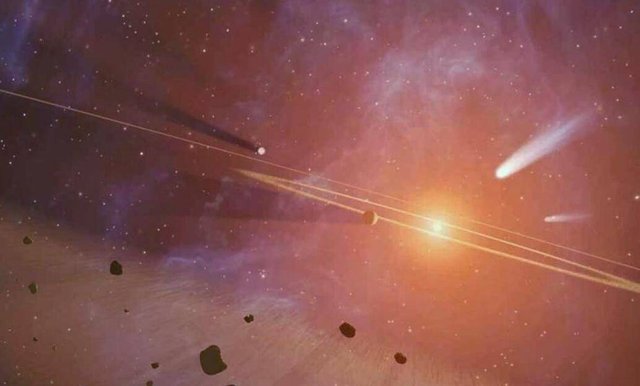
总而言之,在太阳的运动过程中,尽管它撞上与银河系中别的恒星“撞车”的可能性微乎其微,完全可以忽略不计,但从长远来看,别的恒星近距离掠过太阳所带来的风险却不可忽视。
幸运的是,就算“格利泽710”在未来真的会闯入太阳系,人类还有130万年的时间来发展,或许我们可以乐观地认为,到那个时候,人类的科技水平已经足够发达,应该有能力应对这样的事情。
When we feel the tranquility of the years on the earth, the earth has actually been carrying us around the sun at a speed of about 30 kilometers per second. The sun is not stationary, it has also been "leading" Many celestial bodies in the solar system move at high speed in the Milky Way, with a speed of about 230 kilometers per second. The number of stars in the Milky Way is about 200 billion to 400 billion, and the sun is just one of them.
So the question becomes, there are hundreds of billions of stars in the Milky Way, and the sun is flying through it, why doesn't it "crash"? Generally speaking, there are two main reasons for this.
The first reason is that the space occupied by the Milky Way is so large that even if hundreds of billions of stars are distributed in it, it appears to be extremely sparse. How sparse is it? According to scientists' estimates, the average density of stars in the Milky Way is about 0.006 stars per cubic light-year. In other words, the average distance between stars in the Milky Way is about 5.5 light-years. What is the concept?
Let’s put it this way, 1 light year is about 9.46 trillion kilometers, the diameter of the sun is about 1.392 million kilometers, and the standard diameter of a football is 22.1 centimeters. Now let’s assume that there are two stars as large and as fast as the sun, The distance between them is 5.5 light years. In this case, if we shrink these two stars to the size of a football, then after the same reduction, the distance between them will be about 8260 kilometers, and their The speed of movement will be reduced to approximately 0.0365 millimeters per second.
Imagine two footballs 8260 kilometers apart, moving randomly at a speed of 0.0365 millimeters per second. How low is the probability that they will "collide"?
But this is not over yet, because the second reason will further reduce this probability. This reason is: in the Milky Way, the movement of stars is an orderly and regular state, and the movement of most stars is not random. Instead, it follows a relatively stable orbit around the center of the Milky Way, causing the Milky Way as a whole to exhibit a rotating characteristic.
It is precisely because of the above two reasons that the sun does not "collide" with other stars. Of course, it is impossible for the hundreds of billions of stars in the Milky Way to move completely synchronously. There will be more or less relative speeds between them. The sun was formed about 4.6 billion years ago, so it is not difficult for us to imagine that in Over such a long period of time, some stars should pass by the space near the sun.
In fact, "WISE 0720-0846" in the sky in the direction of the Monoceros constellation, about 22 light-years away from us, may be such a star.
"WISE 0720-0846", also known as "Scholz's Star", has a mass of about 9.5% of the sun. It is a red dwarf star. Scientists have discovered that this star is currently moving away from us, and it The tangential velocity relative to us is so low that it is almost negligible. Correspondingly, in the outer regions of the solar system, about 400 small celestial bodies have "exaggerated hyperbolic orbits", which illustrates the past During the day, they were briefly disturbed by some powerful gravitational source.
Therefore, a reasonable conjecture is that in the distant past, "WISE 0720-0846" probably "passed" very close to the sun, so scientists used known observation data (such as its position, direction of movement, and speed) and the gravitational field of the Milky Way, etc.), and then estimated that about 70,000 years ago, this star once passed by about 0.82 light-years from the sun.
What needs to be known is that the radius of the solar system is about 1 light-year (bounded by the Oort Cloud). In other words, based on this estimate, "WISE 0720-0846" has actually broken into the solar system. Guilty.
So, since stars are likely to have invaded the solar system in the past, will other stars invade again in the future? The answer is: it's possible.
According to observation data sent back by the Gaia satellite, scientists discovered that a star named "Gliese 710" is constantly approaching the sun. This star is located in the constellation Serpens in the sky, about 62 meters away from us. Light years.
According to scientists' estimates, "Gliese 710" will break into the solar system in about 1.3 million years, and its closest distance to the sun will be as low as 0.1663 light-years.
It can be seen that this distance is much closer than "WISE 0720-0846". On this basis, plus "Gliese 710" is an orange dwarf star with a mass much greater than "WISE 0720-0846". Its mass is about 57% of the sun, so scientists are generally worried about it.
It is conceivable that after a star with such a huge mass breaks into the solar system, the orbits of many small celestial bodies in the solar system will be significantly disturbed, which will lead to a significant increase in the risk of the earth being hit by small celestial bodies, and even the movement of the earth. Orbits may be affected, which is obviously not good news for humans.
All in all, during the movement of the sun, although the possibility of it "colliding" with other stars in the Milky Way is very small and can be completely ignored, in the long run, the impact caused by other stars passing the sun at close range will The risks cannot be ignored.
Fortunately, even if "Gliese 710" really breaks into the solar system in the future, humans still have 1.3 million years to develop. Perhaps we can be optimistic that by that time, humankind's technological level will be sufficiently developed. Should be able to deal with something like this.